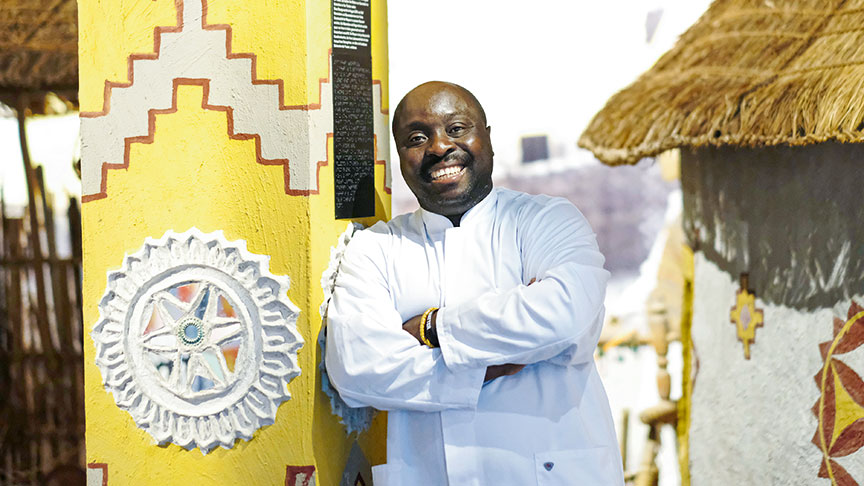Text: Christina Iglhaut
“Knowledge is like a baobab”
Religious objects, deities and icons: German studies specialist, colonial historian and DAAD alumnus Dr Ohiniko Mawussé Toffa aims to clarify where the items stored at GRASSI Museum of Ethnology in Leipzig stem from, who they were taken from and how they came to Germany.
Husband-and-wife dolls from Sri Lanka lie next to a wrap-around robe for men made of brightly coloured wool crisscrossed with embroideries of shiny metal threads. In the neighbouring glass display cabinets stand a temple amulet, guardian figures from Indonesia and the Indian deity Ganesha from the state of Tamil Nadu. The small silver signs that explain what you are looking at frequently read “Collection unknown”. This is precisely what Dr Ohiniko Mawussé Toffa and his team at the GRASSI Museum of Ethnology in Leipzig want to change. Toffa comes from the town of Aného in southern Togo. He came to Germany in 2015 with a DAAD scholarship to complete a doctorate at the University of Bremen. Today he works as a research assistant in a project called Provenance of Colonial Period Collections from Togo that is funded by the German Lost Art Foundation and based at Leipzig Ethnological Museum and the GRASSI Museum of Ethnology (State Ethnographic Collections of Saxony). Some 1,000 artefacts from different cultures and families that were colonised in Togo are being investigated there. They can all be traced back to eight colonisers, including, among others, Oskar Marx, Harry Grunitzky and Dr Hans Gruner. Ethnologists now aim to clarify their provenance and their so-called “acquisition circumstances”. Where did the artefacts come from? Were they appropriated by violent means? And how did they come to Germany?
Toffa and Julia Pfau, the collection administrator for Africa, look for answers in the “Care Room”. They examine the stored items and discuss advances in their research. Museum visitors can watch them at work through a pane of glass. “This transparency is very important to us. In this area of the new permanent exhibition we are focusing more on our work behind the scenes: on provenance research and restoration,” explains Pfau. Specific plant fibres or types of wood, fur or leather can all provide clues as to where the objects originally came from. Toffa’s expertise and his socialisation in Togo help in this process. “I know many of the objects from home, immediately recognise the region in which they are found, what their traditional uses were and what they mean to the people there.” They often involve religious objects, deities, icons. The object that Julia Pfau is now carefully lifting onto the table in front of them from a trolley is also one that Toffa knows from his native country: a talking drum belonging to the “paramount chief”. “In Togo it is called an Atopani; it is a religious object and may only be beaten by initiated individuals. Then people assemble to carry out ceremonies or announce news,” explains Toffa to the collection administrator, who has meanwhile sat down at the computer and begun entering details into the database. “Subject category: music, dance; subgroup: membranophone”.
“The consequences of colonisation are for me unfortunately part of everyday life.”
If Toffa and Pfau discover who the original owners of the artefacts were and that they were taken unjustly, the museum no longer exhibits them and attempts to establish contact with their communities of origin. “I would like to contribute to this drum eventually returning to Togo again,” says Toffa as he inspects a small hole in its leather membrane.
Toffa seeks to uncover further clues about artefacts’ origins and “acquisition circumstances” not only by doing research in archives in Germany and Togo, but also by reading letters between the colonisers and museums and experience reports of expeditions by the “collectors”. In the process he has also come across his own surname. Toffa’s family was directly affected by colonisation for a long time. “One of my ancestors was enslaved in northern Togo; my parents are the second generation since Togo’s independence. For me, unfortunately, the consequences and influences of colonisation are part of everyday life.” His father’s descriptions of experiences with the Germans were rather positive. “Don’t be so lazy, be a bit more like the Germans,” he was told after school. When Toffa examined his own family history and colonisation, however, the archive records told a different story. “This dissonance fascinated me. That’s how I came into this field of research.”
Then, as a result of the DAAD scholarship, Toffa gained another new perspective on things, because during his stay he conducted research with researchers from all over the world and above all from different African countries – for example, Egypt, Burkina Faso and Benin. “In the process I learned that my conclusions and opinions are not universal, and I must constantly subject myself to critical scrutiny,” says the colonial historian. “In Togo we say: knowledge is like a baobab, an African monkey-bread tree, which you can never hold in your arms alone because of its girth. It is the same with knowledge. We always need exchange.” —
Meet Dr Ohiniko Mawussé Toffa in the video and visit the GRASSI Museum with him.



